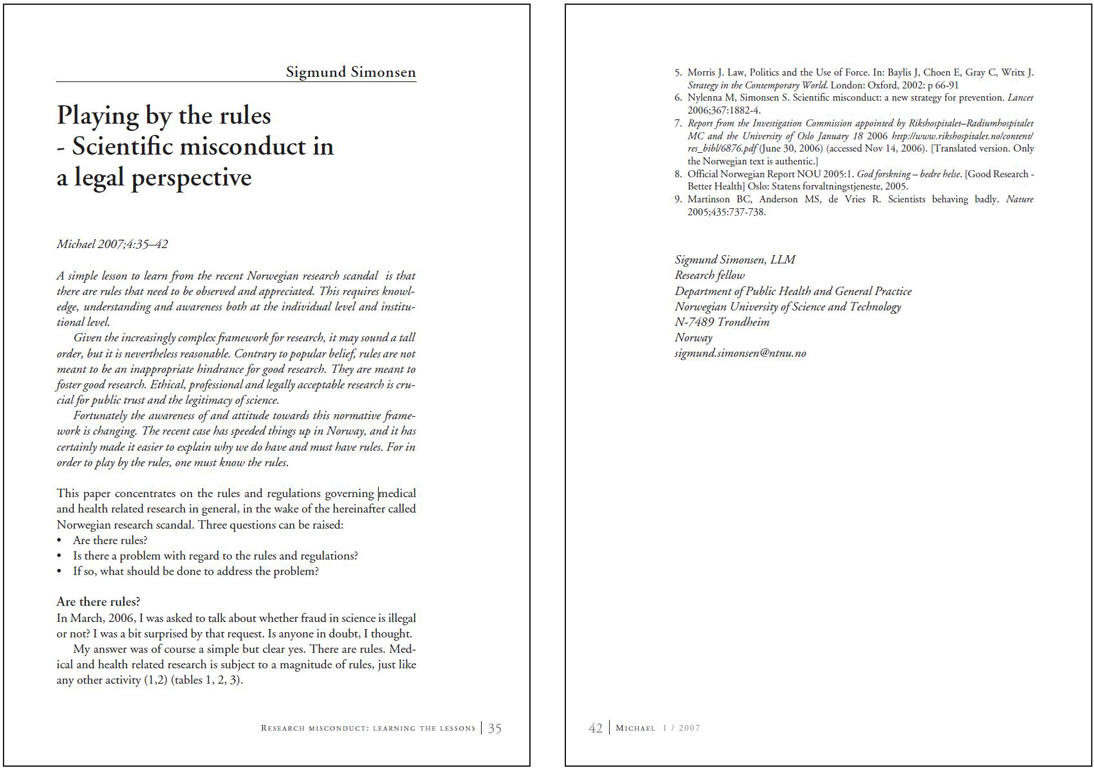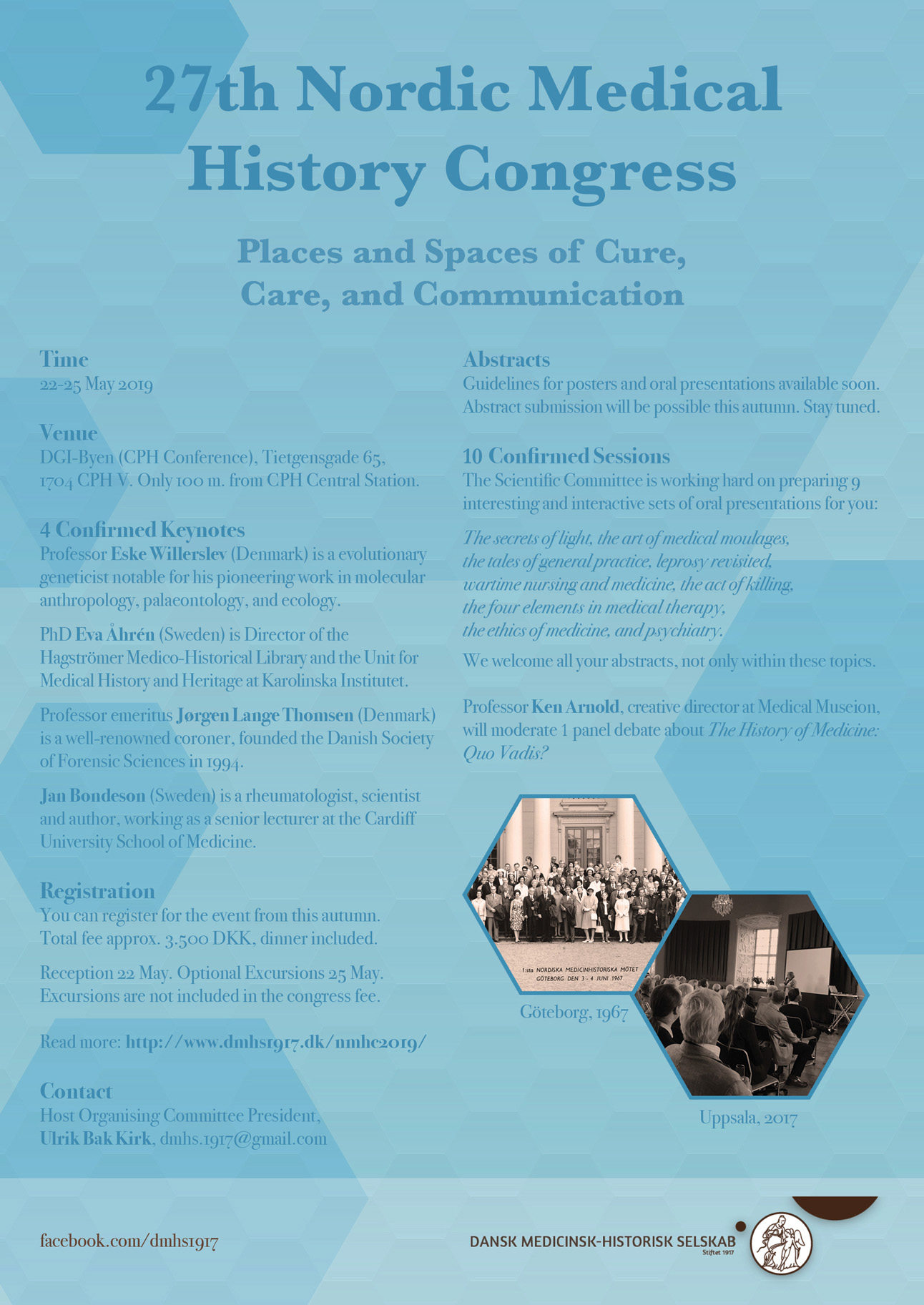Michael – Instructions for authors (revised 2018)
Michael 2018; 15: 292–5.
General
Michael (www.michaeljournal.no)is a publication series published by The Norwegian Medical Society (Det norske medicinske Selskab, www.dnms.no).
Michael is an open access journal published electronically at the same time as the printed version is distributed to the individual subscribers.
Michael presents high quality papers on topics within the range of interests held by the Society. Such topics include medical history, public health and other general issues on health and medicine of relevance to a wide readership.
Michael is published four times a year. Supplementary volumes are published at irregular intervals. All scientific manuscripts are subject to peer review.
Michael publishes articles in Norwegian or in English (UK), depending on topic and main readership. Other languages may be considered if found applicable by the editors.
Papers
Review articles as well as original articles are welcome.
All material submitted should in general conform to the Recommendations for the Conduct, Reporting, Editing and Publication of Scholarly Work in Medical Journals (the Vancouver style: www.icmje.org).
Articles should normally not exceed 3 000 words and 30 references, but exceptions may occur.
The contents of original articles should be arranged in the customary order: Abstract, Introduction, Material and Methods, Results, Discussion, Conclusions, although these chapters may be given other headings for reasons of style.
The title page should bear the name of the author(s) and the title of the article (brief but comprehensive) (bold). Page two should start with an abstract (italics), not exceeding 200 words. Section titles should be given in bold and, if necessary, a second (paragraph) level of titles should be given in italics. A list of the authors’ names, addresses (including e-mail) and affiliations should be given after the references (italics).
References should conform to the Vancouver style, being numbered consecutively in the order in which they are first mentioned in the text. Only published and publicly available papers should be included among the references. Consecutive references should be marked in the text with arabic numbers in parenthesis, starting at (1). All authors for each source should be listed when they are six or less. When there are seven or more authors, names should be given for the first six, with an added: et al. Book-titles and names of periodicals should appear in italics. References to archive material should clearly identify the archive and include a proper document address.
Authors may ask for the editors’ consent to publish articles from e.g. history or social sciences in a format often used in these fields, where references and comments are given in footnotes or endnotes. References should then be written in the Vancouver-style and appear only in the notes. Arabic numbers are used for the notes.
Paper based references are preferred. Net-based sources should be clearly identified so that readers may be able to retrieve them also in the future. Citations from the net should also be identified by the date they were visited.
Figures should be submitted electronically, preferably in jpeg-format (min 300 dpi), and mailed as separate attachments. They must be professionally drawn and photographed. Letters, numbers and symbols must be clear and in proportion to each other.
Figure legends should be placed under the figure and should be written in italics. Figures should add to the contents of the article, and be referred to in the text as e.g. Figure 1, with a corresponding Figure 1: at the beginning of the figure legend.
Tables should be typed double spaced, each on a separate page, with heading and number underneath, written in italics. As for figures, letters, numbers and symbols must be clear and in proportion to each other.
Photographs should be dated, when possible. For pictures and other illustration material from archive sources, proper references should be given. Photographers and other artists should be duly credited in the figure legend. Reproduction fees which may be charged by archives and libraries, should be covered by the author(s) directly upon acceptance of the manuscript. General illustrations or photographs bought from picture agencies are not accepted in Michael.
Colour photographs and graphs may be reproduced in colour, but they should also be fit for being printed in black and white, if so decided by the editors. This is especially important for graphs, where e.g. lines must be drawn in such a way that they are easy to understand even if they are reproduced in black and white.
Copyright issues etc. have to be cleared by the author(s) prior to submitting the manuscript. This applies also to photographs where it is felt customary to obtain consent from the person(s) appearing.
Figures and tables should not duplicate information given in the text of the article.
If applicable, short Acknowledgements may be added at the end of the article, after References.
The article should have the name(s) of the author(s), address(es), affiliation(s) and e-mail-adress(es) at the end.
Proofs are sent in pdf-format by e-mail to the corresponding author. Authors are requested to check their proofs carefully for printer’s errors and return them within 48 hours.

Example of the first and the last page of a Michael-paper in print:
Submitting of the manuscript
Manuscripts should be submitted by e-mail in Word-format.
All authors must give signed consent to publication and give the e-mail address of the author to whom correspondence and proofs should be sent. Manuscripts should be named with the first author’s family name and a key word/short title and submitted by e-mail to one of the two editors:
magne@nylenna.no
oivind.larsen@medisin.uio.no
Contact address:
Michael, c/o professor Øivind Larsen
P.O.Box 1130 Blindern
N-0318 Oslo, Norway

